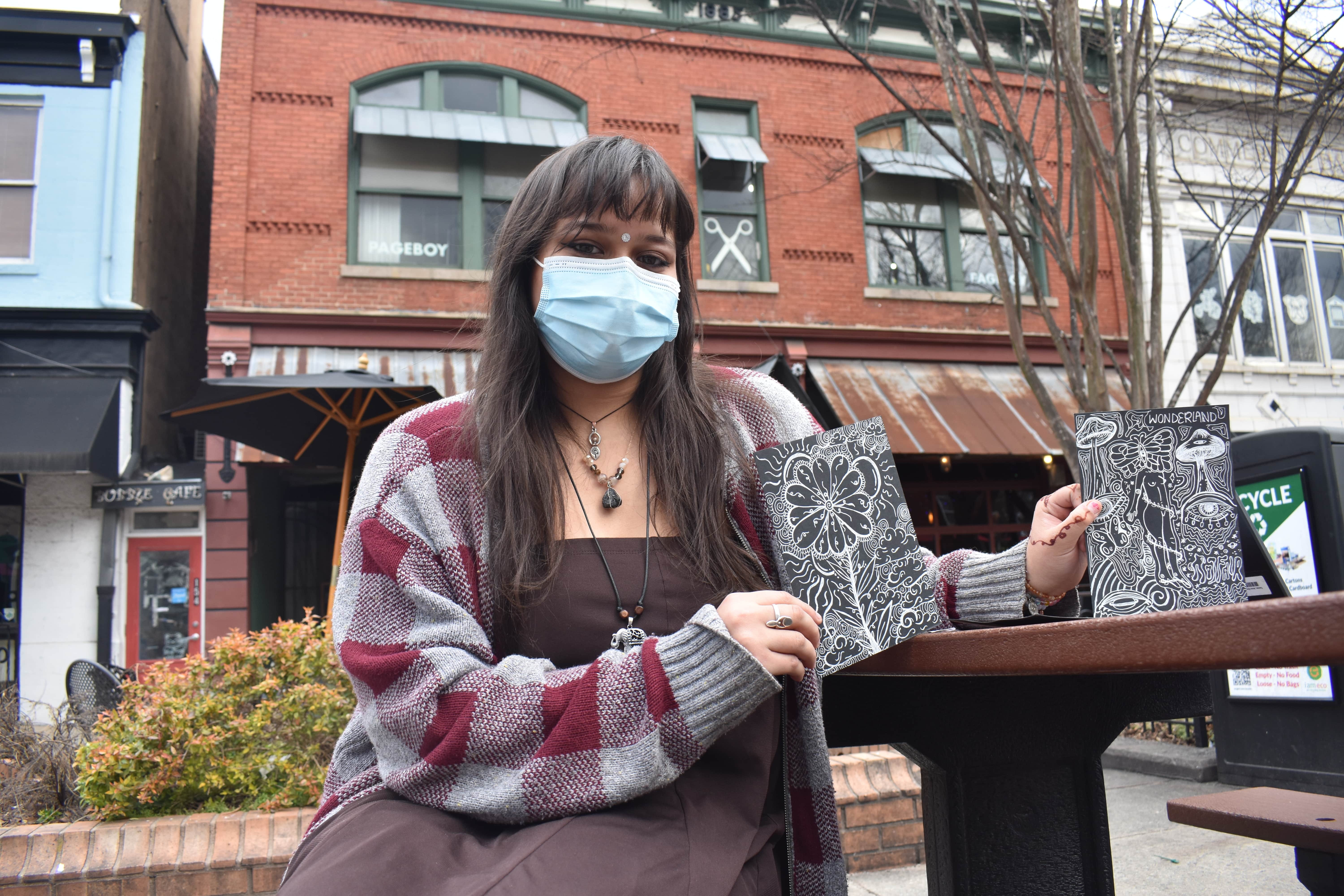Clarke Central High School junior Aiyanna Bhuiyan presents her art pieces in the College Square Plaza on Feb. 17. Bhuiyan has used her art to explore her Middle Eastern culture. “I’ve been doing art my entire life, being creative (in) that way,” Bhuiyan said. “It’s cool to see how I’ve been feeling throughout my spiritual journey. My art has really changed over this past year during quarantine. I really started connecting with spirituality and who I am, what I am here for, (those) types (of) existential questions. My art (has) grown with that.” Photo by Chloe Sears
CCHS junior Aiyanna Bhuiyan discusses her connection to her art and family with Variety staffer Anna Tenner.
Variety Staffer Anna Tenner: When did you first get into art, and why?
CCHS junior Aiyanna Bhuiyan: I really got into line work* because my grandma would take a coloring book, and it’d (have) cartoony figures with easy lines to copy. Then she would take a piece of printer paper and tape it over it and put a light underneath our glass table. I would be able to trace the lines and it really helped my hand get a lot steadier. I think it’s something that was a cool idea because I was already tracing things.
*Pen and pencil designs
AT: What motivates you to continue creating art?
AB: I think art is something that you can do no matter how much money you have. So even when I was super poor, I could still create art. When you play the guitar, you have to (own) a guitar in order to play it. Art, you can just draw it. If there’s any young artists out there, it’s not unrealistic — they should definitely pursue that dream as best as they can. Even if they don’t have money, try to pursue it. Get a job, save up, go through college, get a better job, save more money and then try to go to art school, because it’s really expensive.
AT: Can you tell me about your cultural background?
AB: My dad is from Bangladesh and my ancestors are from Egypt and Pakistan, so I have a lot of Middle Eastern descent, as well. I do my henna all the time, that’s part of my culture, and (wear) dots on my forehead, that’s also part of my culture. I really like the food. I visited Bangladesh once when I was little. It was really fun, but I don’t really remember it. I remember you can’t drink the water. You have to boil it first before you can drink it. So when I was a baby, my mom (said), ‘Don’t even worry about drinking.’ I’ll just eat mangoes and get the water and juice and nutrients from mangoes.
AT: How has your cultural background influenced your art?
AB: In a huge way. I really like mandalas**. They’re a bunch of different shapes and flowers and patterns altogether. Mandalas are the main thing that people henna on themselves. It’s something that’s always been incorporated with my culture. It’s what I like to do. I would go to a lot of Bengali weddings from my dad’s side of the family and when we would get our henna done, it would just be like a bunch of mandalas and lines and patterns and stuff, so that’s what I incorporated a lot in my art.
**A configuration of symbols that represents the universe in various spiritual traditions such as Hinduism and Buddhism, according to Merriam-Webster
AT: In a dream world, what would you want to do with your art?
AB: A tattoo artist. I love lines, and if you love lines, you should be a tattoo artist. I’ve really wanted to do tattooing for a pretty long time, probably (since I was) a freshman in high school. I think tattoos are awesome. They look really cool, and your art will be on someone else’s body forever. I think that’s awesome. If I do become a tattoo artist, sketching every single drawing that I do, especially if someone just gives me an idea, then I’ll sketch it out. If someone sends me a picture, then I’m still going to sketch it out in a different style because I don’t want to tattoo anyone else’s work. I want every single (tattoo) that I tattoo on someone to be my work so I’m not taking anything from another artist.
